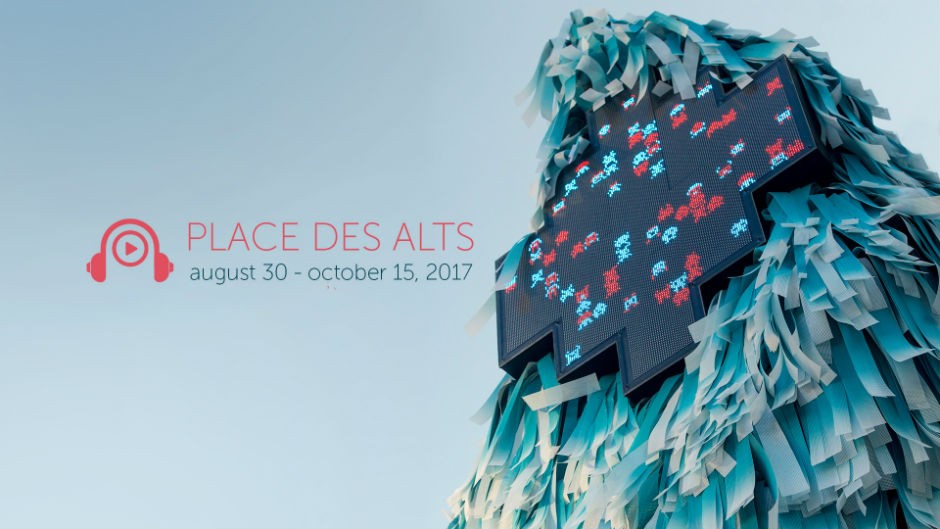William Robinson is an inaugural Concordia Public Scholar. He works in the Centre for Technoculture, Art and Games. He has recently launched a card game with the Centre for Learning and Performance about federal politics called Cabinet Shuffle.
Blog post
Place des Alts

The Project
You can now experience 20 newly installed artworks in Montreal’s Place des Arts. My own is a collaborative project with four other members of Concordia’s community (Tony Higuchi, Eileen Holowka, Gina Hara, and Prof. Lynn Hughes). Titled Place des Alts, the piece gives an “alternative” tour of the area. Together we made an interactive audio-guide, featuring two large sculptures and a re-imagining of a classic spot the differences game. What follows is a reflection on our design process from my own perspective. What I hope to leave you with today are two lessons I continually forget. I would encourage you to see our work at the intersection of Balmoral St. and Saint Catherine St West. Bring headphones and an internet enabled device so you can visit www.placedesalts.com and get the audio tour.
The Lessons
Nearly one year ago, in preparation for Montreal’s 375th birthday, KM3 gave curatorial oversight to Daily tous les jours to fill the area around Place des arts with public works. They commissioned Professor Lynn Hughes, asking that she provide a playful experience for the Place des festivals, which is right next to the Museum of Contemporary Art. Prof. Hughes held repeated brainstorming sessions at the Centre for Technoculture, Art and Games. There, over a dozen students and faculty proposed a variety of projects. We quickly realized that we were facing one very serious challenge:
New experiences are hard to communicate
Of course, technology is hard to deploy. Polish is hard to apply. Live testing can’t happen until its almost too late. Oh, and budgets crush dreams. But at the end of the day, people are impossible to anticipate and when you are making something cutting edge, you are going to suffer. You are going to suffer because so many people will misunderstand the experience you are trying to create for them.
When the project began, we had three different aspects: narrative, sculpture and gameplay. Each of us took care of one of these and built it to impress our peers. We deployed advanced techniques and attempted to have all three be novel kinds of experience. It turns out that you cannot do that. Experts are okay with small changes. The general public is much more cautious. And when you decide to push the limits on three kinds of experience at once, you create chaos, even for the experts. So, we scaled back.
From my own perspective, the game I wanted to make needed to convey the idea of fact finding. The project as a whole is unified by the premise that there are stories you want to hear and stories you need to hear. In my case, the plan was to create a game which embodied this idea metaphorically. The original plan, which I still stand by, was too complicated to explain and then play out in 25 minutes. 25 minutes, was we anticipated a generous audience member in this context would allot us. In a nutshell, the player would receive images of the space that they would need to recreate with their phone’s camera. All of these images would be selfies of our protagonist, and while the alignment would be a little difficult, it was also going to be a treasure hunt. Players would ask themselves “where was this image taken?” Along with those images would be a simple question: “what was she [the protagonist] looking at when she took the photo?” While it seems trivial to ask someone to go somewhere and look in a certain direction, in practice, it fails repeatedly.
The final project is not much different and in the end better highlights our target ideas. The best part is that gets me to a second piece of advice I keep reproducing for myself:
Steal someone else’s wheel and improve it
Making things from scratch is too hard. In every pre-existing object, there are hundreds of invisible design decisions already present, already solving problems you did not know you had. They say do not reinvent the wheel, and they are right. That said, there is always space for alteration. In the end, the game I designed is none other than a suped up Spot the Differences. I cannot go further without spoiling the narrative. What I will say is that it took a while to make my peace with this choice.
I was brought on as a game designer, and in my mind that meant I needed to deliver a novel and special game. It turns out that what I needed to deliver was a deceptively simple, but compelling one.
About the author


